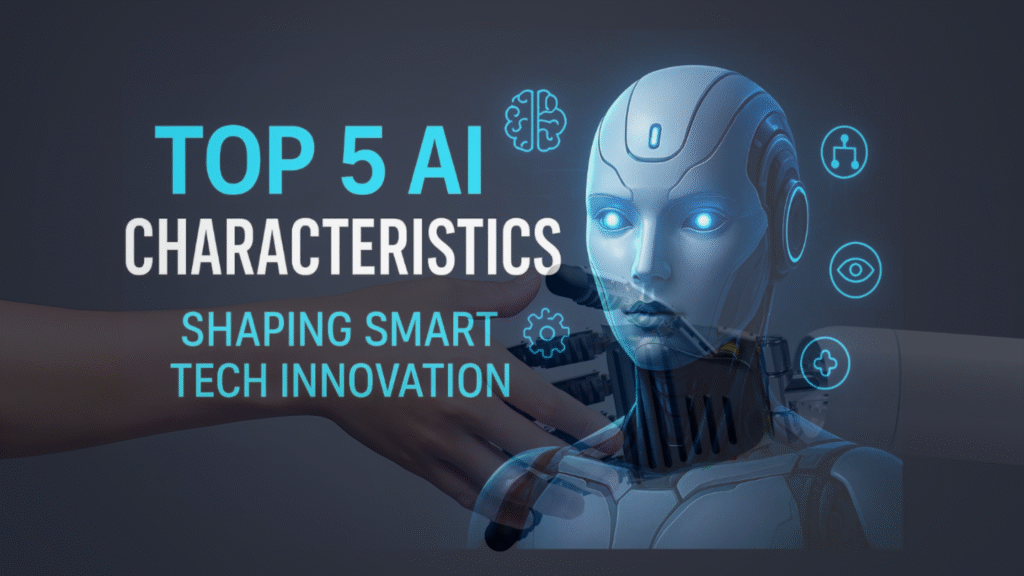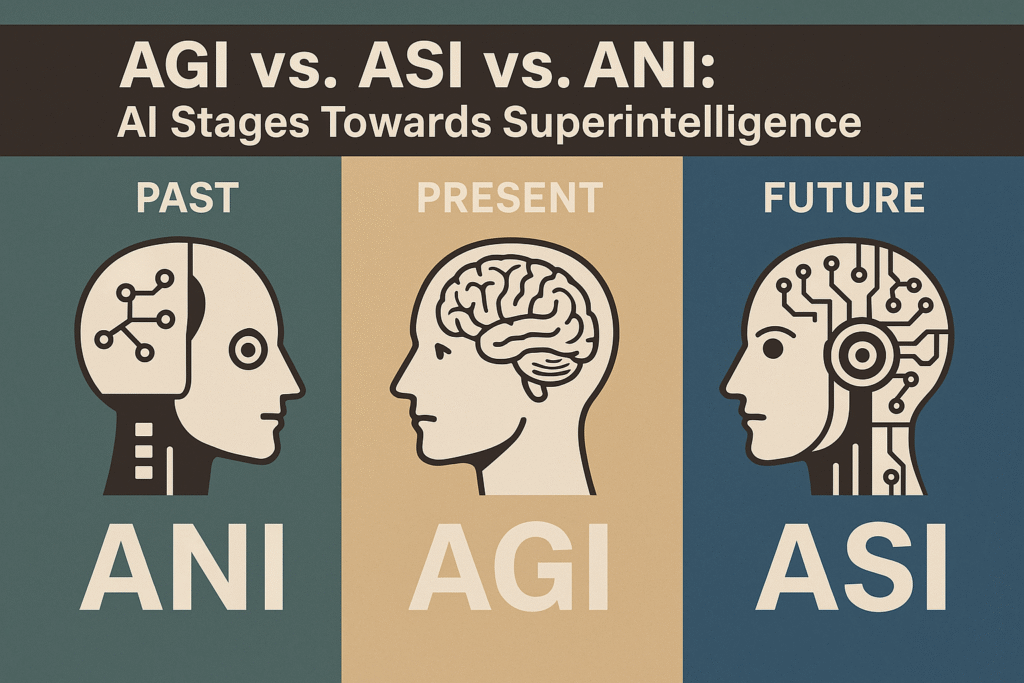Artificial Intelligence (AI) is no longer science fiction, it has become a part of our everyday lives, business operations, and society. From voice assistants on our phones to forecasting tools in companies, AI is transforming how we live, work, and make decisions. But what makes AI truly “smart”? To understand this, it’s important to look at the key characteristics that define intelligent machines. Here, we look at the top 5 characteristics of Artificial Intelligence, why they matter, how they operate, and how they are manifested in everyday applications.

1. Learning Ability
At its essence is the capacity to learn to improve over time by analyzing data, detecting patterns, and adapting behavior without direct re-coding thereof each time. As explained by IBM, “AI enables computers and machines to simulate human learning, understanding, reasoning, problem-solving, decision-making, creativity and autonomy.”
When an artificial intelligence system is given huge quantities of data, it can detect extremely subtle links which may not be noticeable to a human and then adjust its pre-programmed logic to accommodate. For example:
- A movie recommendation on an online streaming service learns what you watch and suggests movies or TV programs you are likely to enjoy.
- A spam filter does not start being effective at filtering out unwanted messages until after it has looked at millions of examples.
Within this learning capability, we generally recognize three types:
- Supervised learning: Where the system is trained on labeled data (e.g, pictures of cat vs dog).
- Unsupervised learning: Where the system learns implicit structures or clusters from unlabeled data.
- Reinforcement learning: Where the system experiments with actions and receives feedback (reward or penalty) in order to learn in the long run.
It is widely recognized that without learning, an AI system is static and unable to adjust to new situations. For instance, based on a report on AI features, The most characteristic feature of AI is that it can learn and improve based on experience, instead of using pre-specified rules.
In short, Learning is the driving force behind AI expansion, and it separates intelligent systems from formalized rule-based automatons.
2. Reasoning & Decision-Making
Another such key characteristic is reasoning to evaluate information, draw conclusions, select among alternatives, and act sensibly. As McKinsey & Company defines it, “AI is a machine’s ability to do some cognitive tasks we like to think of as uniquely human, such as perceiving, reasoning, learning, interacting with the world, solving problems, and even exercising creativity.”
What does this mean in real-life terms? For example:
- In medicine, AI software is able to read symptoms of a patient, access history of a patient and generate possible diagnoses.
- In banking, reasoning software filters an application for a loan based on considerations of risk factors and previous behavior.
Reasoning most often involves several strategies:
- Deductive reasoning: Applying a general rule to a particular case (e.g., If all patients with X symptoms have disease Y, then this patient probably has Y).
- Inductive reasoning: Concluding general principles from particular cases (e.g, concluding what spam is from numerous instances of spam).
- Abductive reasoning: Supplying best-guess explanations under uncertainty (e.g, making educated guesses at underlying causes where data are limited).
Reasoning, in practice, drives AI from “processing data” to “interpreting data”. Reasoning enables machines to transcend mere procedures and make decisions as close as possible to human reasoning.
3. Perception
The most human-like aspect of AI is perception, making sense out of sensory data (vision, hearing, text) and knowing the world. Palo Alto Networks identifies some important features of advanced AI as learning and adapting to new situations, the ability to reason, plan, and solve problems in various contexts.
There are many forms of AI perception:
- Computer vision: Object recognition, face recognition, scene recognition, gesture recognition (e.g., autonomous vehicles recognizing pedestrians and traffic lights).
- Speech-to-text recognition: Speech translation and transcription into text, intent recognition (e.g., virtual home assistants).
- Sensor fusion: Combining data from a set of sensors (cameras, lidar, microphones) to produce a combined perception.
- Natural language processing (NLP): Recognizing human language (spoken or written) and producing an output.
With awareness, AI is now capable of interacting with the world surrounding us that was once controlled by humans. It allows machines to “see,” “hear,” “read” and react, bridging the gap between data processing pure and embodied cognition.
4. Adaptability & Continuous Improvement
One of the defining features of modern AI is flexibility, a capability to change performance over time in response to variable conditions or input. AI systems, according to sources, must contend with new input, shifting environments, and changing user behavior.
Adaptability shows up in various ways:
- Learning on the web: Models that learn and update incrementally in real-time as new data arrives (e.g., e-commerce websites that customize offers based on real-time shopping behavior).
- Transfer learning: Moving learning in one domain to another (e.g., applying image recognition systems learned on ordinary objects to transfer to medical imaging).
- Meta-learning (learning how to learn): Systems that learn to modify their learning strategy.
Being adaptive, AI systems stay current. They stay pertinent to changing situations whether changing rules, shifting customer dynamics, or new fields of deployment.
Complementing adaptability is automation once an AI system learns and adapts, it can automate complex tasks reliably. While automation may sometimes be treated as an outcome rather than a core characteristic, its integration with adaptability amplifies AI’s value. For instance, a manufacturing plant might deploy AI-powered predictive maintenance, the system learns from sensor data, adapts as new failure modes appear, and automatically schedules maintenance before breakdowns occur.
This blend of flexibility and automation transforms AI from a short-lived trend into a lasting force, one that continually drives productivity, intelligence, and innovation.
5. Problem-Solving & Autonomy
While the above four properties cover most of what is offered by AI being “smart”, there is one more basic property that is often supplied by AI developers as being separate from AI and that is problem-solving in incomplete contexts and autonomy that it can operate independently, make decisions, plan and execute actions in dirty, dynamic worlds. For instance, it is noted by a source that problems of AI tend to grapple with addressing dynamism, uncertainty, context-sensitivity, and interaction, all characteristics of real-world problem-solving as it is practiced.
What this means:
- They have to function when the data is poor or incomplete but must still come up with sound decisions.
- They have to deal with dynamic environments, and thus the system has to change strategy.
- They must interact with humans or other agents, share information, and provide feedback in real time.
Autonomy follows naturally, if an AI is able to learn, reason, sense, adapt, and solve problems, it is able to operate with or without human intervention. Autonomous drones change flight paths according to weather and air-traffic conditions, or logistics networks reroute shipments on their own when traffic bottlenecks occur.
By integrating these characteristics, AI is not just a tool anymore but an able companion operating intelligently within intricate real-world situations.
Types of Artificial Intelligence

Understanding the different types of AI puts into perspective how these characteristics are utilized in the real world.
- Artificial Narrow Intelligence (ANI): Also known as Weak AI, these computer programs exist to accomplish one task like voice assistant, image recognition, or product recommendation. They are brilliant at a specific area but lack general awareness.
- Artificial General Intelligence (AGI): The next hypothetical leap machines that can understand, learn, and apply knowledge on various tasks at human-level performance. AGI is presently largely hypothetical.
- Artificial Superintelligence (ASI): A speculative future form of AI surpassing human intelligence in almost all areas, whether creativity or strategic thought. ASI raises profound ethical and safety concerns.
In each type, the five characteristics described earlier play a role, though with differing breadth and depth ANI might be excellent at sensing and learning in a particular domain but AGI/ASI must be fully adaptable, reason, be autonomous and have problem-solving across domains.
Why These Characteristics Matter
Why must AI systems learn, reason, perceive, adapt, and solve problems autonomously? Because collectively they constitute the cornerstones for what provides the transformative potential of AI:
- Efficiency & automation: AI can automate bulk or repetitive tasks with limited human intervention.
- Accuracy & insight: Through data learning and logical reasoning, AI systems facilitate improved insight and more precise action.
- Scalability: Agility permits AI systems to scale out into new geographies, domains, or types of users.
- Innovation: Autonomic trouble-shooting permits firms to try out new products, services, and business models.
- Personalisation & user-experience: Perceiving and learning enable user-centric responses to deliver more tailored experiences in sectors like healthcare, finance, education and transport.
These characteristics are actually what’s making AI possible to get used across industries of all types manufacturing and logistics to healthcare, cyber-security, retail and more.
Ethical and Practical Issues
The stronger AI becomes, the greater the stakes are. Absolute power does come with absolute responsibility. Some of the ethical and practical issues are:
- Bias & fairness: The use of biased learning data can introduce unfairness in reasoning and decision-making.
- Transparency & explainability: The more autonomous AI is, the more stakeholders and users are interested in understanding how it arrived at a conclusion.
- Safety & robustness: To function and react independently in real-world settings, AI systems must be tolerant of errors, resistant to adversarial attacks or unforeseen events.
- Privacy & security: Perception and learning data-hungry also raise data privacy, observation and abuse concerns.
- Job displacement & human-machine interaction: With AI taking on more autonomous problem-solving and automation, organizations need to handle workforce impacts and human-machine collaboration with care.
By recognizing these challenges and designing AI systems with ethics and governance in mind, organizations can capture the potential of AI while minimizing risk.
Conclusion
Artificial Intelligence is far more than just trendy terminology, it represents a profound shift in how machines operate, learn, perceive and act. The top 5 characteristics we’ve explored are learning ability, reasoning/decision-making, perception, adaptability/automation, and problem-solving/autonomy together define the essence of intelligent systems.
With an understanding of these features, organizational stakeholders, developers, and users can better appreciate what AI can currently do, what it will do in the future, and how it should be regulated sensibly. With its continuous development and innovation through sectors, awareness is intrinsic features that help guide strategy implementation and regulations.
The future of Artificial Intelligence lies not just in what it can do, but in how responsibly we shape its role in society.
Related Link:
- Understanding the Ethical Issues in Artificial Intelligence
- Beginner’s Guide to AI Algorithms: What You Need to Know
- 5 Best AI Assistants
- Top 5 AI Cost Optimisation Software in 2026
FAQs
What is the main characteristic that defines Artificial Intelligence?
The most fundamental characteristic is that it can learn from experience or data, improving over time without being re-programmed explicitly.
How do AI characteristics affect day-to-day life?
These characteristics drive applications in the real world such as tailored recommendations (perception and learning), voice-controlled virtual assistants (perception and reasoning), autonomous vehicles that learn and adapt to novel roofscapes (adaptability and problem-solving), and many more that enable today’s life to be smarter, more efficient and networked.